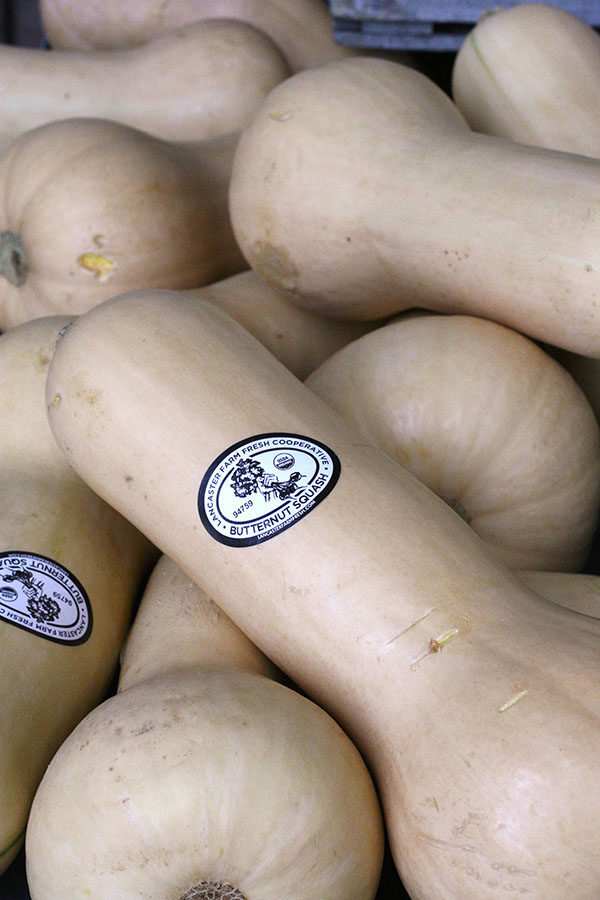The bounty of summer is long gone but fall brings its own special harvest to the table. Squash is in full-force right now at grocery stores and farmers markets. These nutritional power-houses are packed with vitamins and fiber. They can be used to lighten-up recipes by replacing starches such as pasta and potatoes. They can also be the star of the show when roasted alone. Squash also tends to be pretty kid-friendly because of it’s sweet flavor and ability to pair well with cinnamon and other dessert-like spices.
There are so many varieties that it’s difficult to keep track of them all. You have probably thought to yourself “Wow, those colors and shapes are beautiful. If only I knew what to do with them…” Well, fret not! We have put together this handy-dandy guide to some of the most popular squashes on the market, complete with recipes and directions for preparing them. We hope you find it useful as you hunker down for cooler weather and heartier meals.
Squash #1: Delicata

Delicata is the easiest of the squashes to prepare. It’s thin skin is edible so there is no need to peel them. All you have to do is slice length-wise from end to end, scoop out the seeds, then slice as necessary. This squash is not as rich in beta-carotene as other winter squashes, but is a good source of dietary fiber and potassium, as well as smaller amounts of vitamins C and B, magnesium, and manganese.
The recipe below makes a fabulous side-dish for Thanksgiving.
Maple Sage Roasted Delicata Squash (from A Family Feast)
Serves 4-6
INGREDIENTS
2 pounds whole delicate squash
3 tablespoons extra virgin olive oil
2 teaspoons Kosher salt
2 tablespoons butter
2 tablespoons fresh sage, cut into pieces
2 tablespoons real maple syrup
DIRECTIONS
1. Preheat oven to 425 degrees.
2. Slice off both ends of the squash and discard. Cut the squash in half end to end and with a spoon, scoop out seeds and discard. Then cut into one inch thick half-moon slices leaving skins on. (The skins can be eaten!)
3. Place in a bowl and toss with oil and salt then lay out on a sheet pan and bake for ten minutes. Flip, and then bake for 10-15 more minutes until tender.
4. While squash is roasting, heat butter and sage in a small sauce pan with maple syrup for a few minutes to incorporate flavors. Set aside.
5. When squash comes out of the oven, toss with butter and sage mixture and serve immediately.
Squash #2: Pumpkin (and Heirloom Pumpkin)

Pumpkins are not just for carving. They are full of antioxidants and vitamin A. They can be used in soups, pastas, breads and baked goods (see our Butterscotch Frosted Pumpkin Cookies). Sadly, real pumpkin probably isn’t in that pumpkin spiced latte from Starbucks. Some recipes call for peeling, cutting and baking the squash, and others (such as Bobby Flay’s soup below) call for canned pumpkin puree. This soup has a delicious, spicy heat that really brings out the flavor of the pumpkin.
Pumpkin Soup with Mexican Cinnamon Creme Fraiche and Toasted Pumpkin Seeds (from Bobby Flay’s Mesa Grill)
Serves 6-8
INGREDIENTS
3 tablespoons unsalted butter
1 large onion, coarsely chopped
2 cloves garlic, coarsely chopped
1 large carrot, peeled and coarsely chopped
2 stocks celery, coarsely chopped
7 cups vegetable stock, or water
1 1/2 cups pumpkin puree (not flavored pie filling)
1/4 teaspoon plus 1 teaspoon ground Mexican cinnamon
1/4 teaspoon allspice
1/4 teaspoon ground ginger
1/4 teaspoon freshly grated nutmeg
2 tablespoons honey
2 teaspoons chipotle puree
3/4 cup creme fraiche or sour cream
Salt and freshly ground pepper
1/2 cup toasted pumpkin seeds
DIRECTIONS
Heat the butter in a medium stockpot over medium heat. Add the onions, garlic, carrots and celery and cook until soft. Add the water and bring to a boil. Reduce heat and simmer for 20 to 30 minutes. Strain the stock into a clean medium saucepan and whisk in the pumpkin puree until smooth. Bring to a simmer and add the 1/4 teaspoon cinnamon, spices, honey and chipotle. Cook for 15 to 20 minutes. Add water, if the soup is too thick. Remove from the heat and whisk in 1/4 cup of the creme fraiche and season with salt and pepper to taste. Mix together the remaining creme fraiche and remaining 1 teaspoon cinnamon until combined. Divide the soup among 4 bowls and garnish with the cinnamon creme fraiche and a handful of pumpkin seeds.
Squash #3: Kabocha
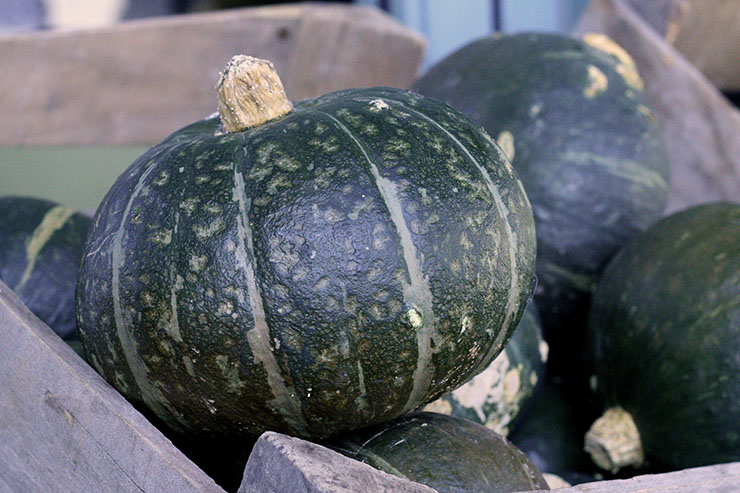
Kabocha, or Japanese Pumpkin, is an Asian variety of winter squash. It’s very sweet in flavor and has the texture of a sweet potato. You have probably had it in vegetable tempura and thought it was sweet potato. Kabocha is rich in beta carotene, iron, vitamin C and potassium. This would be a great addition to your rotation of weekly meals for it’s nutrition alone.
The recipe below is a creative and somewhat exotic way to incorporate squash into a flavorful meal.
Thai Red Curry with Kabocha Squash (from Eat, Live, Run)
Serves 4
INGREDIENTS
1 large kabocha squash
8 oz firm tofu, cut into bite sized chunks
1 large handful green beans, cut in half
1 red bell pepper, diced
2 kaffir lime leaves, torn (check your local Asian market for these)
6 Thai basil leaves, chopped (check your local Asian market for these, too)
1 tbsp canola oil
3 tbsp red thai curry paste (not sauce…paste)
1 (15-oz) can coconut milk
1/4 cup water
1 tbsp fish sauce
2 tsp brown sugar
2 red thai chilies, pierced several times with a knife
cooked jasmine rice for serving
DIRECTIONS
1. Preheat oven to 400 degrees. Drizzle olive oil on a foil lined sheet tray. Slice kabocha squash, remove seeds, and place cut-side down on the sheet tray. Roast squash halves for about 30 minutes until tender. Remove and let cool completely.
2. In a large pot or deep pan, heat the canola oil over medium high heat. Add the curry paste and mash into hot oil so all the paste gets incorporated. Then, slowly drizzle in the coconut milk, whisking continuously until all milk has been added and no curry “clumps” remain.
3. Add water, torn kaffir lime leaves, thai basil, fish sauce, brown sugar and thai red chilies and bring to a simmer. Add red bell peppers and green bean halves and continue simmering sauce for about 15 minutes until vegetables are just cooked but not mushy.
4. Peel or slice kabocha squash away from peel. Chop into large chunks and add along with the tofu to the curry sauce. Serve curry over jasmine rice (don’t eat the chilies!).
This winter squash has a sweet, nutty taste similar to a pumpkin. Butternut squash can be used in breads, soups, casseroles, you name it. It’s high in fiber, vitamin C, manganese, magnesium, and potassium. It is also an excellent source of vitamin A and vitamin E. The recipe below treats butternut like a potato and twice-bakes it with a delicious stuffing. This dish makes for a perfect vegetarian meal.
Twice-Baked Butternut Squash with Quinoa and Chanterelle Mushrooms
Serves 6-8
INGREDIENTS
4 lbs. butternut squash (2 regular-sized squashes)
2 cups quinoa
1 cup chanterelle mushrooms, sliced
1/2 cup white onion, chopped
½ cup grated parmesan cheese
3 tablespoons olive oil, separated
2 cloves garlic, minced
water
salt and pepper, to taste
DIRECTIONS
1. Preheat oven to 450 degrees
2. Cut squashes in half, take the seeds out and place, cut side up, in two 11×7 baking dishes. Season with salt, pepper and olive oil (one tablespoon per squash), and add 1/4 inch of water to baking dishes.
3. Cover baking dishes with foil and bake for around 40 minutes, or until tender when pierced with a fork.
4. Reduce oven temperature to 375º F
5. In a small pot, bring 4 cups water to a boil and then add quinoa. Reduce to a simmer and let cook for 15-20 minutes, or until quinoa has absorbed all water. Remove from heat.
6. In a pan, heat remaining olive oil and sauté mushrooms and onions on medium heat. Add the garlic after a few minutes. Cook until fragrant and onions are translucent.
7. After squash has cooled, scoop out the insides, leaving about a 1/4 inch of flesh.
8. In a large bowl, combine quinoa, butternut squash, mushrooms, onions and garlic, and parmesan cheese. Mix well and season with salt and pepper.
9. Spoon mixture back into the hollow butternut squashes and return them to the oven for 20-25 minutes, or until top is golden brown.
Squash #5: Acorn
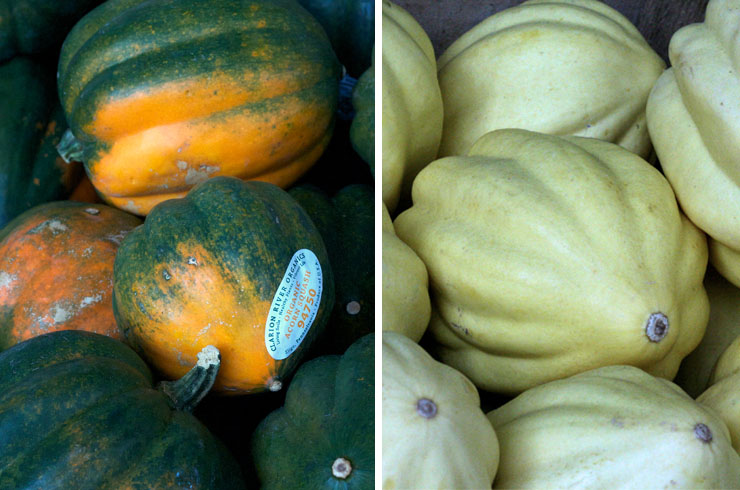
Acorn squash can be green, gold, white or multi-colored. While not as rich in beta-carotene as other winter squashes, it is a good source of fiber and potassium, as well as smaller amounts of vitamins C and B, magnesium, and manganese. This squash more than any other makes me think of fall. I have stuffed and baked them with every imaginable ingredient. When looking for a recipe to feature here, I chose something a little different. The rice dish below could also make for an amazing side at Thanksgiving or with a holiday goose.
Black Rice with Roasted Acorn Squash (from A Spicy Perspective)
Serves 4-6
INGREDIENTS
1 1/2 cups black rice (wild or forbidden)
2 Tb. butter (oil for Vegan)
2 shallots, peeled and diced
1 cup pecan pieces
Zest of 1 orange
2 Tb. fresh thyme leaves
2 Tb. vegetable oil
1 acorn squash, peeled seeded and diced
Salt and Pepper
DIRECTIONS
Set a medium sauce pot over medium heat. Add the butter and shallot and saute for 2 minutes. Then add the rice and toss to coat in butter. Add the appropriate amount of water as directed on the rice package (from 3-4 cups depending on the variety of rice.) Add 1 1/2 tsp salt, cover, and bring to a boil.
Once boiling, stir, lower the heat to medium-low, cover, and simmer until cooked through–follow time directed on rice package.
Meanwhile, preheat the oven to 450 degrees F. Toss the peeled and diced acorn squash in oil and spread over a baking sheet. Roast in the oven for 15 minutes. Turn and spread the acorn squash again and roast another 10 minutes. In the last 2-3 minutes sprinkle the pecans over the acorn squash so the pieces can toast.
Once the rice and roasted acorn squash are ready, toss together with orange zest and thyme. Then salt and pepper to taste. Serve warm of room temperature.
Squash #6: Sweet Dumpling
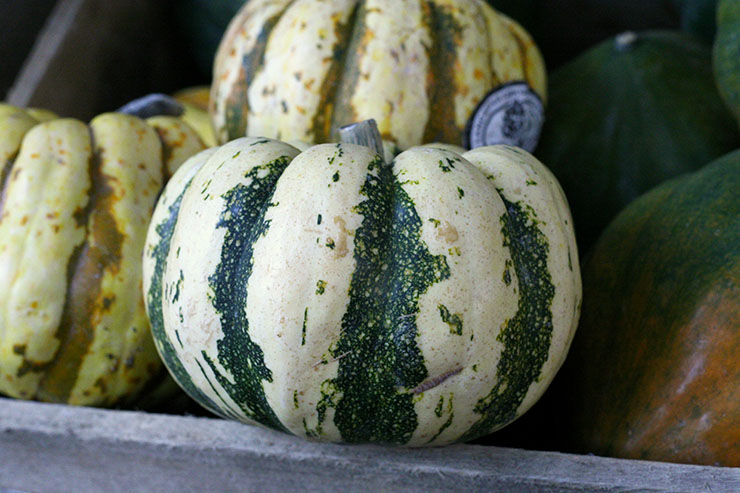
I have always thought of these gems as decorative because they come in a variety of colors and cute little sizes. But, low and behold, you can eat them too! Sweet Dumplings have a delicate and sweet flavor and are fairly easy to prepare. To peel them, dip the squash in boiling water for 1 minute, then into ice water. It should peel easily.
Make the dish below or try adding Sweet Dumplings to your favorite chili recipe.
Black Bean and Sweet Dumpling Squash Chili (from The Partial Ingredients)
Makes about 6 quarts
INGREDIENTS
2 tbsp olive oil
2 tbsp butter
2 yellow onions, diced
1 jalapeno, minced
4 cloves garlic, minced
3 sweet dumpling squash, skins removed, chopped into bite-sized pieces
45 oz. red kidney beans, drained and washed
45 oz black beans, drained and washed
4 cups sweet corn
29 oz. tomato sauce
29 oz. water
4 chipotle peppers in adobo, chopped
1 tbsp adobo sauce (from the can)
2 tsp cumin
2 tsp allspice
2 tsp cinnamon
2 tsp smoked paprika
1 tsp chili powder
salt and pepper to taste
sour cream, for garnish
cilantro, for garnish (optional)
green onion, chopped for garnish (optional)
DIRECTIONS
Mix the dry spices in a bowl. In a 8-10 qt. sauce pot heat the butter and oil and add the onions. Cook on medium high for about 5-8 minutes. Add the minced jalapeno and garlic and cook until fragrant, about a minute. Add the squash and stir, cook for about a minute. Add the black beans, kidney beans, corn, tomato sauce, water, chipotle sauce, chipotle peppers, and spices. Adjust seasoning to taste. Cook covered for about 40-45 minutes, or until the squash is fork tender but not mushy. Garnish with sour cream, cilantro or green onions and serve.
Squash #7: Spaghetti
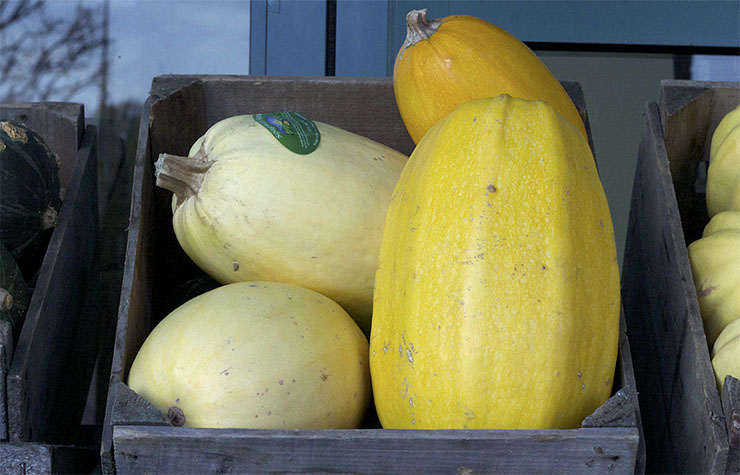
Spaghetti squash is a great source folic acid, potassium, vitamin A, and beta carotene. The more yellow the squash, the more beta carotene it contains. It is also extremely low in calories, about 42 calories per cup. Because it’s flesh is similar to spaghetti (hence the name) I love to use it in place of actual pasta. Just cut in half, remove the seeds, bake until tender, then pour bolognese on top. BAM, dinner is served!
The following recipe uses spaghetti squash like you would shredded potatoes in latkes/hash browns but is far healthier.
Spaghetti Squash, Bacon and Parmesan Fritters (from Julia’s Album)
Makes 8 fritters
INGREDIENTS
2 eggs
1/3 cup flour (for gluten free version, use multi-purpose gluten-free King Arthur flour)
3 cups spaghetti squash, cooked
1/2 cup Parmesan cheese, freshly grated
1/4 + 1/8 teaspoons salt
3 green onions, chopped
5 bacon strips, cooked, drained of fat, and chopped
2 tablespoons olive oil
2 green onions, chopped
dollop of Greek Yogurt
DIRECTIONS
Preheat oven to 425 Fahrenheit. Cut the squash in 2 halves, scrape the seeds and the fiber out of each half. Spray oil over the cut sides of the squash. Spray the baking sheet with oil and place the squash on the baking sheet cut side down. Bake for about 30-40 minutes. Remove from the oven when cooked through and soft. Let cool. After squash cools, scrape squash with a fork to remove flesh in long strands and transfer to a bowl. Cool some more.
Important: Wring out the spaghetti squash by wrapping portions of it in paper towels and squeezing hard with your hands over the sink. Drain as much liquid as possible. Squash can be refrigerated and made the next day to allow spaghetti squash to drain and dry out.
Fritters
In a large bowl, using electric mixer, beat 2 eggs on high speed for 1-2 minutes. Add flour and continue beating for about 30 seconds to combine.
To the same bowl, add spaghetti squash, Parmesan cheese, 3 chopped green onions, and 1/4 + 1/8 teaspoons salt. Stir very well until the mixture has uniform consistency. Add chopped bacon and stir.
Heat a large skillet on high-medium until VERY hot. Only then add olive oil. It should sizzle and smoke right away. Using a tablespoon for each fritter, spoon the batter into the skillet. Using a spatula, correct the shape of each fritter, making it flatter and rounder. Cook until the bottom of each fritter is golden brown, about 1-2 minutes. Reduce heat to medium. Using spatula, flip fritters over, and cook 1-2 more minutes. Turn off the heat and let the fritters sit in the skillet (uncovered) for 2-3 more minutes (check the bottom for burning – if it is too dark, remove fritters from the skillet immediately).
Serve as is or top with the dollop of Greek yogurt and chopped green onions.
For more delicious recipes and food guides, check out our articles about Clam Season and Goat Cheese.

